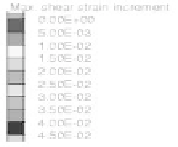Geoscience Reference
In-Depth Information
The numerical model demonstrates that the dam remains stable. Only small
deformations and displacements are generated by the earthquake for a maximum
acceleration of 0.12 g. No failure threshold is reached during this seismic loading.
10.6.7.7.
Justification of the lower dam failure during the 1971 earthquake
The results of the seismic loading calculation of the lower dam show a good
agreement between the curves giving the isovalues of the shear strain and the
observed shear bands (see Figure 10.14). Shear strains greater than 5% correspond
to the slip zone, whereas the zones with calculated shear strains greater than 20% do
not coincide exactly with the geometry of the observed failure zone. Therefore, the
5% shear strain criterion is representative of the failure zone. The liquefaction factor
increased within the whole soil mass at the base of the embankment by up to 80%,
which agrees with the analysis that liquefaction was the cause of the failure of the
upstream facing and of the core. The calculated displacements are significant,
although smaller than the real ones; they reach 7 m for horizontal displacement of
the upstream facing and 5 m for the vertical settlement of the dam. All the stability
criteria have been exceeded.
Figure 10.14.
Comparison between reconstituted in situ and calculated shear bands for
the 1971 earthquake (from top to bottom: shear strains <5%, shear strains <20%,
liquefaction factor, horizontal displacement and vertical settlement)





Search WWH ::

Custom Search